Introduction
After General Guide To Leader Abilities In Gwent, we moved into more detailed breakdown, faction-by-faction, following the alphabetical order. This time we visit the 2nd faction in the order: Nilfgaard (if you haven’t read it yet, here is the link to the preceeding Monsters chapter).
Each leader ability would be accompanied by a short characteristics, most important synergies (importance rated with stars) and example decks.
All demo decks presented in the series could also be found in a Google Sheet.
Imprisonment
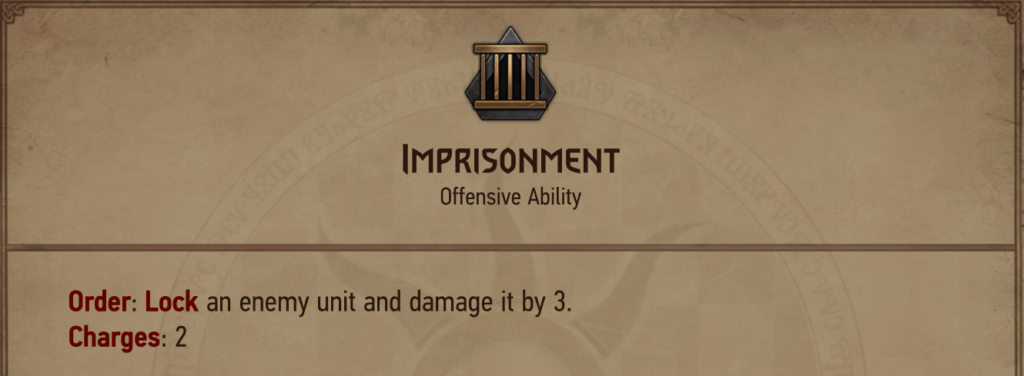
Imprisonment is a control leader ability, with very weak pointslam (6 raw points). It may support some low cost Nilfgaard bronzes (Van Moorlehem Servant, Master of Disguise, Thirsty Dame…), but completely lacks synergy with Nilfgaard high-end. Synergies:
- Overload Control *** | Imprisonment is a perfect leader to deal with multiple engine threats in one turn; for example Impisonment + Alba Armored Cavalry could shut down all engines after Madam Marquise Serenity is played with Tribute.
- Hand Freedom *** | Compare with Overwhelming Hunger in the Monsters leaders guide. Imprisonment gives free access to control, so that less control cards have to be run in the deck and kept in hand. It is especially important when we want to maximize full hand synergy payoff.
- Sequence Freedom ** | When we face engines posing bigger threats than ours, they have to be answered before our own ones get deployed. With Imprisonment it is possible to develop own engines and answer opponent’s at the same time, which adds extra points thanks to better sequencing; possibly huge points if engines scale non-linearly due to mutual synergies.
- Engine Skirmish / Round Control ** | Very often round 1 is a contest of bronze engines, while gold cards have more pointslam / high floor character. Then in Round 1 commiting one Imprisonment leader charge could have high effective value, while being less of a commitment than in the case of any other Nilfgaard leader. Such a strategy requires very specific decks, heavily reliant on round control, like Cloggers.
Imprisonment is the sheriff of Gwent ladder, ready to bring back law and order whenever the meta goes too engine heavy. Imprisonment does not support any particular archetype or high-end card.
Demo decks:
- Imprisonment Drunken Illusionists – Imprisonment leader value frees the hand for pure pointslam strategy. This deck heavily relies on Illusionists finding good target, often wants to defend the push in Round 2 starting from Ale of the Ancestors; unless the opponent manages to 2:0, this deck could achieve a very good carryover in spite of no typical short round cards.
- Imprisonment Nekker Cloggers – Imprisonment could be committed in Round 1 in order to gain round control. Thanks to leader charges it is possible to clog opponent and control their engines at the same time (and also beat the Kolgrim menace – An Craite Longship). Matta helps to tutor 10c Nekker (Gwent 11.11) and combos with guardian spawned by Cynthia; also may elongate Kolgrim grow by 1 turn.
- Imprisonment Cloggers Sandor Abduction – Imprisonment frees hand in order to play clog and thinning cards exclusively. Abduction has anti-synergy with Kolgrim, but is a very strong card when combined with Sandor. Because of the Abduction echo, this deck thins 10 cards as default.
- Imprisonment Renfri Puppeters – As Alba Armored Cavalry is a good bronze control soldier, Imprisonment is not the main pick for Renfri Soldiers deck, because control usually isn’t so lacking. 5-cost slot isn’t really stacked in Renfri NG when Ard Feiann Light Cavalry / Imperial Marines couldn’t be conveniently run, unless… This sneaky version plays Masters of Puppets and Vilgefortz: Renegade. The idea is to move Puppeteer into the opponent’s graveyard and get access to 1 power Puppeteer spawned from Illusionist this way.
Imperial Formation
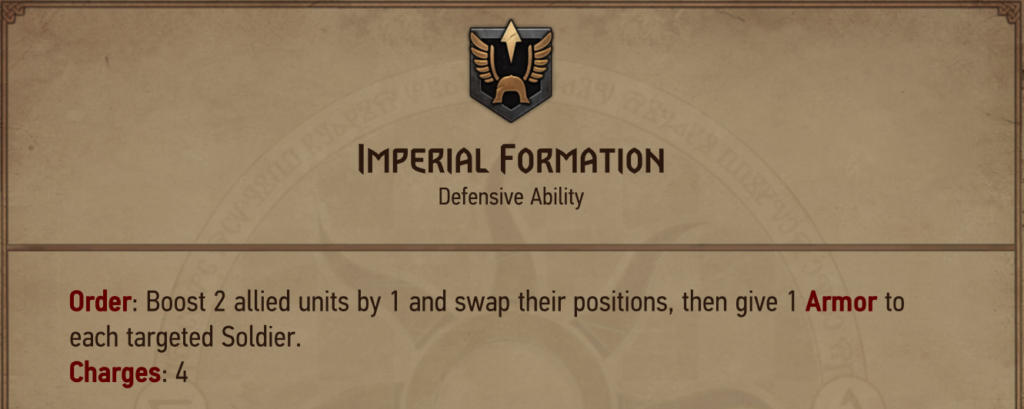
Imperial Formation is a middleground type of leader ability – engine protection synergy accompanied with decent pointslam (8 points + armor on Soldiers). Synergies:
- Engine Soldiers Protection *** | Imperial Formation’s main synergy is protecting soldier engines from removal. IF excels especially in supporting threat overload of multiple engines (Battle Stations…), rather than protecting one or two greedy golds. IF engine protection is rather weak outside Soldiers; it could at most boost a single non-Soldier unit by 4, which is underwhelming compared with leader like Carapace (Monsters leader abilities). On the other hand, dispersed boosts to soldiers could give 8 boost + 8 armor = 16 protection from damage.
- Regrouping ** | Imperial Formation could swap two allied units on the board, which is especially useful when a Flanking soldier gets blocked with a Disloyal unit.
- Random Damage / Weather Effects Counter ** | Outside engine protection, IF could get pure ‘pointslam’ value with armor sinking Weather effects and more or less random damage. In such a case, IF ceiling is 16 points, which is more than the best point slam leaders value (for example Blood Scent is 12 points).
- Armor Payoff | Niche and unused synergy – flanking engine in the back row could stack armor, which is a feed for payoff cards. Unfortunately the only payoff card available is Iris:Shade (Vlodimir has some synergy with stacked armor, but not with IF leader – boost gets wasted).
In Gwent 11.11 Imperial Formation is the main leader to go with the Soldiers archetype, but the core of bronze soldiers package could support various decks and ideas, making it at least easier to fight for round control.
Demo decks:
- Imperial Formation Renfri Soldiers – Imperial Formation helps to protect Ard Feiann Light Cavalry / Imperial Marines; Alba Armored Cavalry provides control, Slave Driver flexibility, Renfri points.
- Imperial Formation Double Madoc – Sappers are neutral Soldiers – they could be copied with Slave Driver and Imperial Formation helps to renew their armor. Deck invests many provisions to be strong in Round 1 which makes it easier to secure a long round with Ivo finisher. Deck is built around Madoc and could suffer when he gets countered. It is possible to build non-Madoc Ivo decks based on Soldiers package too (feel free to swap 2x Remedy with a removal tactic if bricks too often).
- Imperial Formation Giant Spotters – Imperial Formation helps to protect and rearmor Spotters, who are the win condition; Allgod and Offerings are used to boost Nilfgaardian Knight(s) to maximal possible value.
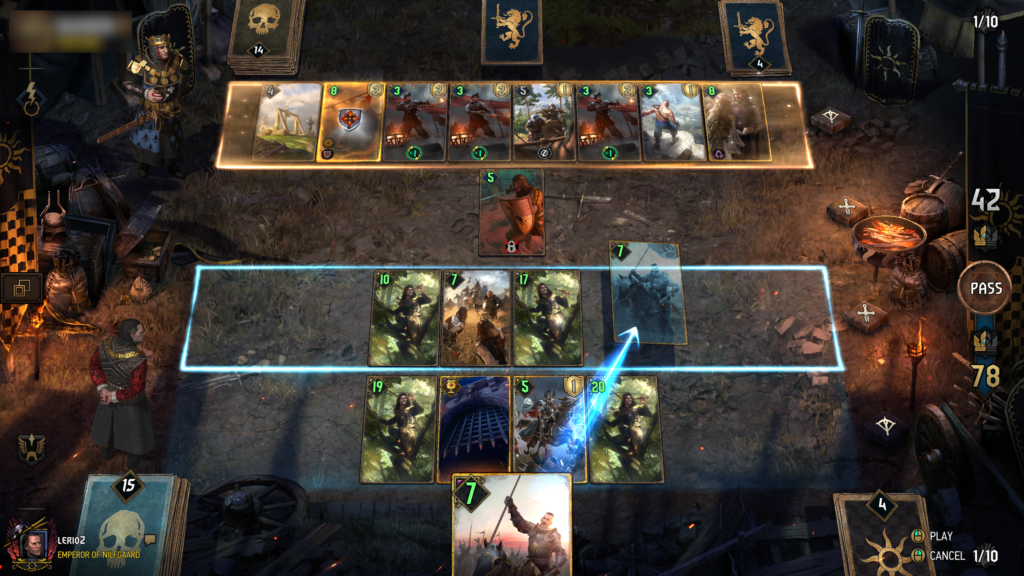
Tactical Decision
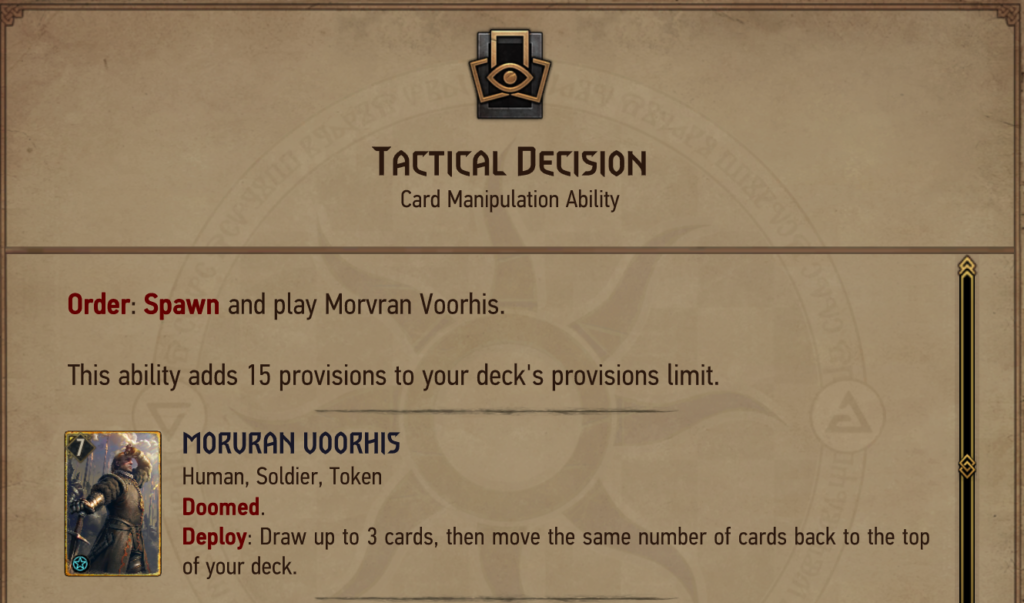
Tactical Decision is a pointslam leader ability, closely tied to 5-cost card Mage Assassin. Instead of 15 provision leader worth 7 raw points, Tactical Decision should in practice be viewed more as 7+2*4(Mage Assassin) = 15 raw points leader with 13 provision (Gwent 11.11). Synergies:
- Thinning *** | Being coupled with Mage Assassins, in order to really reach effective 15 points value, both Assassins have to be found at hand. It is plausible for Tactical Decision deck to thin a lot in order to increase the chance of finding Assassins as early as possible. In reverse, Tactical Decision may help to thin the deck without Blightmaker use.
- Albrich ** | Tactical Decision could trigger additional toss to the top on Albrich, which translates to +4 points or more if Hyperthin payoff cards (Xarthisius, Yennefer: Divination, Triss Merigold) are played.
- Scrolling ** | Tactical Decision could fix the hand (usually just one bad card, because the two other are Mage Assassins) and has higher chance of accessing crucial cards.
- Body * | Morvran Voorhis is a 7 power token, which could additionally support Triss:Meteor Shower, especially in a short round.
- Leader carryover* | Mage Assassins could accumulate carryover for leader ability. Cards like Offering or Allgod could buff them. In case of decks thinning to zero, Assassins could even be mulled out in R2, so that going down to zero cards with no leader use is possible in theory with no risk of missing anything in R3.
Tactical Decision is a very interesting leader mechanically, requiring specific, well-thought deckbuilding. The payoff is a solid pointslam value of 15 points in decks pleasant to play and skillful to manage.
Demo decks:
- Tactical Decision Renfri Fakerthin – a Renfri deck thinning 6 cards and excelling at pure pointslam play. Iris von Everec is used to maximize the payoff from running units only and playing almost all deck.
- Tactical Decision All-in Hyperthin – Hyperthin decks in general thin to 1. In this case, Albrich on steroids is kept in the deck, fueling Yennefer Divination and Xarthisius. Vilgefortz could be played to destroy an opponent’s threat, or defensively to summon Albrich. Hyperthin decks are very satisfying when winning, but also prone to inevitable losses whenever crucial thinning cards are missed. This version is very greedy, but winning with stellar Xarthisius is worth the torment of games lost to consistency issues.
- Tactical Decision Constructs Hyperthin – Frenzied D’ao after rework offers double thinning and may be included in a Hyperthin deck, providing very necessary efficient control. Could also play a similar deck as Midrange Constructs.
- Tactical Decision Engines Hyperthin – Snowdrop and Doadrick are main Letho: Kingslayer targets. When Doadrick is used on a lonely Albrich, moving to the bottom counts as moving to the top. The Last Wish should be used only to finish with Albrich.
Toussaintois Hospitality
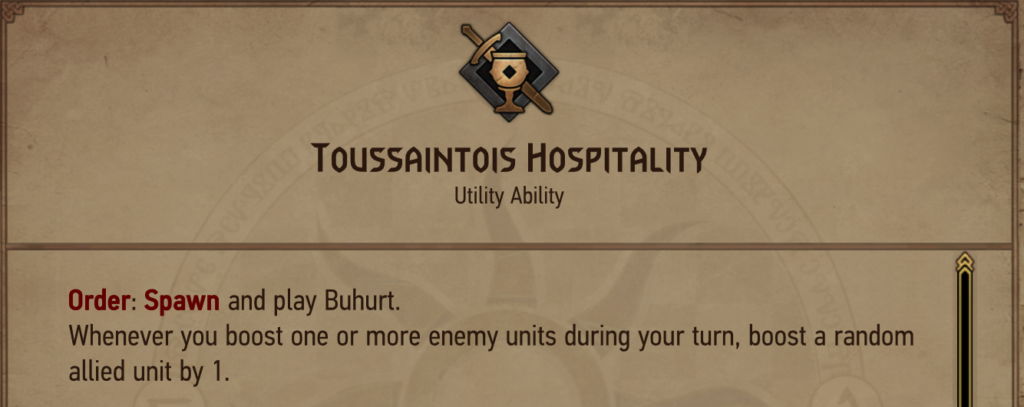
A synergistic leader ability, worth 7 raw points. That being said, False Ciri could turn TH into almost a pointslam leader – 13 points if Ciri goes through with no need of more synergies.
- Enemy Boost – Passive *** | Cards boosting enemy units get improved thanks to the passive part of leader ability; if these cards are already on meta level, then TH becomes one of best leaders in the game.
- Enemy Boost – Retrieving *** | Enemy boosts have to be retrieved, so that they become equivalent to normal points played on own side of the board. Beauclair, Ivar Evil Eye, Regis: Higher Vampire and Master of Puppets are examples of cards returning boosts. Then Buhurt becomes 12 rather than 6 points, Nilfgaardian Knight 10 rather than 8 and so on.
- Enemy Boost – Mediators *** | Milton and Guillaume are mediator cards for Enemy Boost archetype – they are potentially a source of huge points as intermediate when boosting and retrieving works. Milton is more midrange, while Guillaume conditional on hand and board state. Milton alone could be worth 15 points with 1:1 receiving. With Sangreal +12 buff instead of +3 we reach 24 points. Guillaume ceiling is equal to the number of knights in the row +2 +2*amount of boost.
- Low power body ** | The drawback of TH is going tall; +9 boost from Buhurt gives an instant target to tall punish. Setting up a couple of low power targets then makes this leader more convenient; for example Blightmaker into Mage Assassin brings 3 decent boost targets in one turn.
Toussaint Hospitality is a complex leader ability, focused around generating huge number of points via Enemy Boost strategy. It should be supported with some control cards, especially locks. The high ceiling of TH invites deckbuilding experiments; not even Tactical Decision could match TH value in a synergistic deck which works properly.
Demo Decks:
- Toussaintois Hospitality Beauclair Abduction – a twist on pure Enemy Boost deck – Abduction provides short round pointslam.
- Toussaintois Hospitality Puppeters Nekker – best cards of enemy boost archetype (Gwent 11.11): False Ciri and Milton are below 9c. In the absence of Beauclair and Ivar, Masters of Puppets are Enemy Boost receivers; Petri’s Philters become Nekker artifacts in order to secure their value. This version is risky because of Sangreal + False Ciri coupling; feel free to swap Sangreal.
- Toussaintois Hospitality Shupe Calveit – TH is used in a small package with False Ciri to bring pointslam into Shupe decks which generally struggle in their own points output aspect.
- Toussaintois Hospitality Drunken Knights – Ale of Ancestors is interesting with TH – of course we use it on… opponent units. Each order used for enemy boost triggers passive TH ability. It brings extra value to Guillaume and Beauclair. Also could use Mahakam Ale on the enemy unit infused multiple times…
- Toussaintois Hospitality Challengers Swarm (meme) – Knight Challeger has no place in main TH builds in Gwent 11.11; it is too slow and reactive for a bronze to accompany Enemy Boost well. Nevertheless, the card is interesting and has high point potential. The idea of the presented deck is to copy Knight Challenger with Operator in R1, then swarm with them in R3 and launch a cascade of board buffs. Standard Bearer is a payoff card, which could be copied with Ramon and Slave Driver. Unique strategy worth experimenting! A greedier version may run Cahir.
Enslave
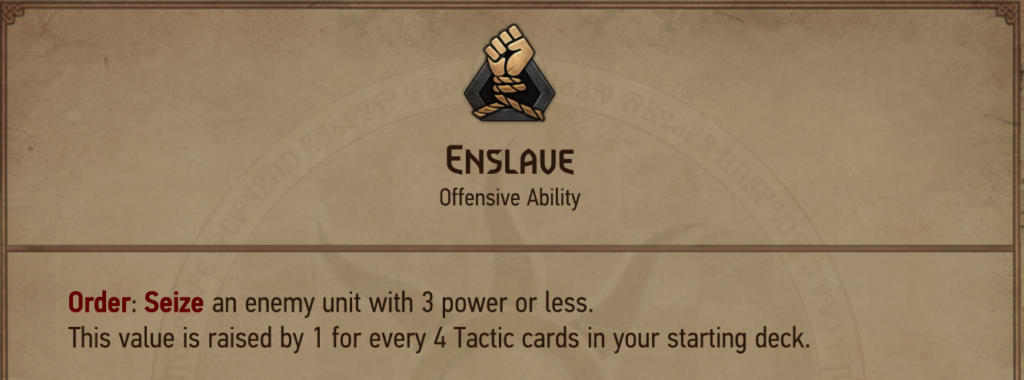
Enslave is a mix of control and pointslam leader ability. The raw points ceiling of Enslave 6 is 12 points, which is relatively high for a control leader ability (compare with Imprisonment). The effective value is even higher when seized unit is an usable engine; stealing a 6 power, +1 per turn engine could be worth around 20 points in a long round. Outside the number of tactics requirement, Enslave is not a very synergistic leader ability and could accompany various decks whenever support of efficient control is needed.
- Setup with Damage *** | – Enslave is limited to the Seize reach unless supported with damage cards. Only small support is needed, because Seize is incidental (for example Stefan Skellen setting up seize of a powerful engine with damage).
- Points Core ** | Enslave doesn’t support any intrinsic ways of generating points – it accompanies best decks with high point output.
- Artaud * | seized unit could be spawned with Artaud
Demo Decks:
Enslave 6 Assimilate – Assimilate provides a high points ceiling in a long round against most decks, Stefan helps to setup Seize, Artaud may be activated with leader ability just in case. Enslave supplements Assimilate with efficient control.
Enslave 7 Kolgrim – an unusual exploit of Jan Calveit, Kolgrim and Enslave power scaling with number of tactics. In spite of 31 cards run in the deck, Calveit guarantees that the crucial high-end would be found every game. Kolgrim value comes from extra cards put in the deck and natural thinning done by opposing deck (while our own doesn’t thin at all). Deck doesn’t care about card advantage in Round 1; going few cards down only impoves Kolgrim value. Ideal R1 hand is Calveit + 9 bronzes (eventually Kolgrim if winning R1 otherwise is impossible). Assire + Roderick are used only to put Kolgrim/Defender back into the deck in Round 3.
Double Cross

Double Cross is a meta-dependent leader ability with a very high variance (~6 to ~20 points). It has some synergy with Assimilate and may be very strong meta call whenever good leader targets are run in the most popular decks.
- Gold Hunting Meta *** | when meta high-end golds are usable for a Double Cross deck, leader ability could regularly get high value. Moreover, such targets preferably shouldn’t be committable early, so that opponent couldn’t play around.
- Assimilate ** | card played from opponent’s deck triggers Assimilate; the upside with respect to other NG leader abilities (Hospitality, Tactical Decision) is that sometimes chosen unit procs Assimilate multiple times (for example Coup into Artaud in an Assimilate mirror)
- Runemage ** | Runemage enhances Double Cross to 5 rather than 3 cards.
- Coup/Artaud Deadlock ** – targets for Coup/Artaud are usually hoarded in hand till very last plays; in such case Double Cross gets giant guaranteed value instead.
Double Cross has some important weaknesses. Leader ability power is varied and troublesome to use when defending bleed; opponent may go all-in with the very last card and DC becomes dead in such a scenario. In Gwent 11.11 Assimilate is coupled with Tactics and Enslave is straight up more stable and convenient leader to use for this archetype, providing missing control.
Demo Decks:
Double Cross Shupe Henry – Runemage is naturally played in Shupe decks, which makes Double Cross a considerable leader pick. In Gwent 11.11 Assimilate cards Artorius Vigo and Braathens are strong after recent power buff. Deck runs multiple create cards improved by Runemage and triggering Assimilate. Compared with pure Assimilate, Shupe builds consist of more control tools, which alleviates DC weakness. In some niche scenarios, Henry could combo with Double Cross, giving us access to a strong Nilfgaard card useless for the opponent.

Imposter
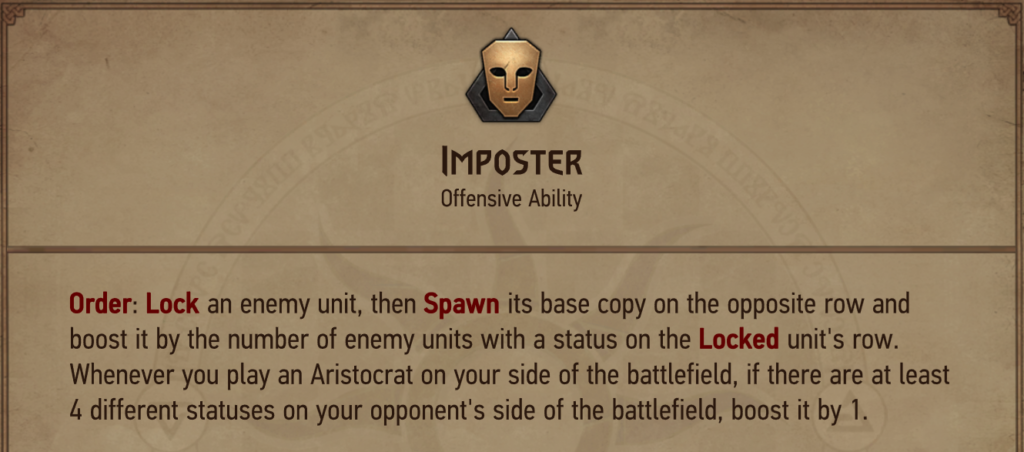
Imposter is a complex leader ability having synergy with Aristocrats and Statuses. In terms of gameplay its impact could be compared with Enslave; provides good pointslam value (~seizing 6 body unit with no effect), or control+copy (~seizing low power engine immediately). Imposter is generally worse value than Enslave against low power engines, but better pointslam vs high base power units. The upsides when compared with Enslave is more deckbuilding freedom (deck isn’t forced to run Tactics) and no damage setup required when threat gets out of Seize range. Imposter counts self, so that copied unit gets at least +1 boost.
Imposter generally prefers long rounds, where more statuses could be applied for pointslam value and where direct lock+copy also brings more effective value.
- Row With Statuses *** | The number of statuses on units doesn’t matter – a unit is counted whenever having at least one status. Consequently this effect is best enhanced with Disloyal units, providing not only status, but also body. At most +9 could be achieved; without Disloyal board clog common bonus would be around +4/+5.
- Statuses Passive ** | Passive part of the leader ability relies on at least 4 different statuses present on the board. The passive part then needs a variety of statuses in order to get triggered; it would never be activated with Spying or Poison only. Convenient statuses:
- Spying
- Poison
- Lock
- Bleeding
Other statuses are incidental, usually would come from the opposing deck. Amongst Aristocrats, Philippe Van Moorlehem could impact a different status: Doomed.
Overall, the Passive part of the leader ability isn’t very impactful, because it requires few turns of board setup. Also Poison status likely wouldn’t be used early unless played with intention of instant removal.
- Lock Payoff ** | Applying Lock status boosts Thristy Dame, possibly improves Admiral Rompally end of turn effect and Van Moorlehem Servant deploy. Outside cards commonly going in Aristocrat decks, Imposter could be combined with Vanhemar for extra removal. To get high value from Vanhemar, such target must be high power, which not necessarily means high base power. Also when Imposter is supposed to be used immediately on a low power engine threat, Vanhemar loses effective points.
- Spawning A Copy ** | Imposter spawns a copy of an arbitrary opponent’s unit present on the board. With Operator it is possible to set up the proper bronze target rather than rely on units coming from the opponent’s deck. Unlike Enslave, Imposter use could be more conveniently delayed on an unit copied with Operator. Consequently, this leader ability has huge synergy with high ceiling engine Idarran of Ulivo. At the moment of Idarran deploy, three engines emerges on the board: 6 power Idarran, slightly buffed Imposter target and its 1 power copy spawned with Idarran. Whether the target would be prepared or incidental, in order to make most out of engine overload, follow-up spawns are needed. An example of copy targets prepared with Operator are
Imperial Practitioners. Played in Round 1 in a combo with Vilgefortz: Renegade they could spawn multiple copies of a card in your hand at the top of the deck (Tibor Spam, Mushy Truffle spam, The Eternal Eclipse spam…). This potentially grants huge, game decisive carryover when the strategy is not disturbed. The most troublesome part is consistency – so many provisions have to be invested into making Round 1 stable, that the deck likely has no other win conditions.
Demo decks:
Imposter Aristocrats – As described above, Imposter is the classical companion to Aristocrats archetype. In Gwent 11.11 due to provision nerfs not the whole Aristocrats package could be fit in and the featured list cut Phillipe Van Moorlehem. Feel free to play around with various Aristocrat cards like him or Joachim de Wett and choose the list which fits you best. Aristocrats scale strongly with round length; they need to win round 1 or pass early without committing Location if difficulties are predicted.
Imposter Idarran Spawnsimmilate – Imposter is used with Idarran without Operator setup. Instead of triggering Assimilate, this deck prioritizes direct spawning enemy units; if Idarran sticks it could be 2 units per turn (but feel free to try Artorius and Braathens too – they reach high value but are just less thematic). Tourney Shaelmaar is a perfect long round finisher payoff for this strategy. Playable meme.
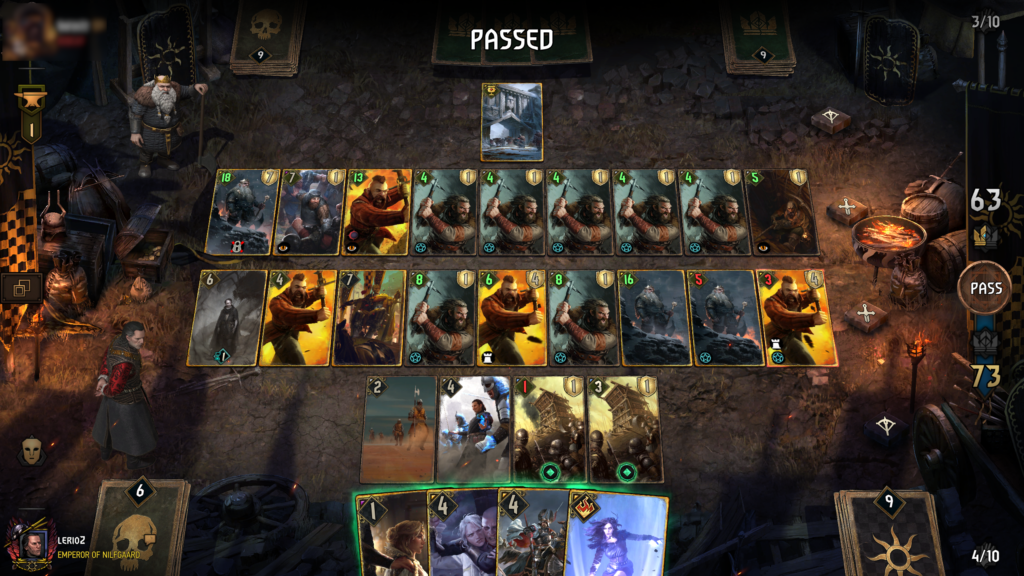
Summary
- Nilfgaard leader abilities are varied when it comes to mechanics.
- While Monsters has no control leaders, Nilfgaard has 3 out of 7: Imprisonment, Enslave and Imposter.
- Many Nilfgaard abilities are not tied to one particular build and have some freedom when it comes to picked strategy / cards used.
Closure
Hope you enjoyed this journey into Nilfgaard leader abilities and maybe would like to try some of presented decks/ideas yourself. Feedback is very welcomed; if you know about other decks/ideas making use of Nilfgaard leader abilities, please let me know – I may update this article accordingly.
All decks from the series could also be found in a Google Sheet.

